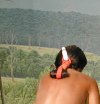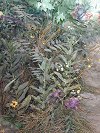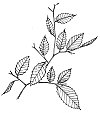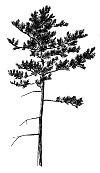A Guide to THE THREE SISTERS Diorama - TREES AND WEEDS
FOREST TREES IN THE BACKGROUND PAINTING OF THE DIORAMA
The background represents a beech-maple forest named for two of the more abundant kinds of trees found in it, American beech and sugar maple. White ash, American basswood, pignut hickory, shagbark hickory, white pine, yellow birch, hemlock, American elm and sweet birch are other trees commonly found in this type of forest. The Iroquois had learned that this type of forest grew on a fertile soil that would be good for their crops. Similar forests grow in the region today. |
When your are at the exhibit, notice that the trees in the background painting are not large, and that they are close together. This is a second growth forest about 50 years old. This new forest invaded an earlier field, which was abandoned because the soil had been depleted by farming. The new forest growth restores the fertility to the soil, and trees of this size are ideal for longhouse construction.
TREES WITH DISTINCTIVE SHAPES
In the background of the photograph: the high rounded crown is a sugar maple (Acer saccharum); to the right of it, the tall tree with horizontal branches is a white pine (Pinus strobus) |
 The scattered dead trees in the background are the American elm (Ulmus americana). These trees died because their bark was stripped off to shingle longhouses. Dutch elm disease, which is currently killing this species of trees in the Northeast, was brought to this continent in modern time.
The scattered dead trees in the background are the American elm (Ulmus americana). These trees died because their bark was stripped off to shingle longhouses. Dutch elm disease, which is currently killing this species of trees in the Northeast, was brought to this continent in modern time.
'WEED' PLANTS IN BLOOM
 These 'weed' plants, which are in the left foreground of the diorama, include some of those found in the area today in late August. Several are shown in bloom for artistic effect; however, in nature, all of these might not be in bloom at the same time, but all bloom in the late summer. All are native plants, but today they would not be the dominant weeds at the edge of a field. Most of our present-day weed plants are immigrants from Europe and Asia.
These 'weed' plants, which are in the left foreground of the diorama, include some of those found in the area today in late August. Several are shown in bloom for artistic effect; however, in nature, all of these might not be in bloom at the same time, but all bloom in the late summer. All are native plants, but today they would not be the dominant weeds at the edge of a field. Most of our present-day weed plants are immigrants from Europe and Asia.
The next Page contains sketches that serve to identify the weed plants in the diorama.



